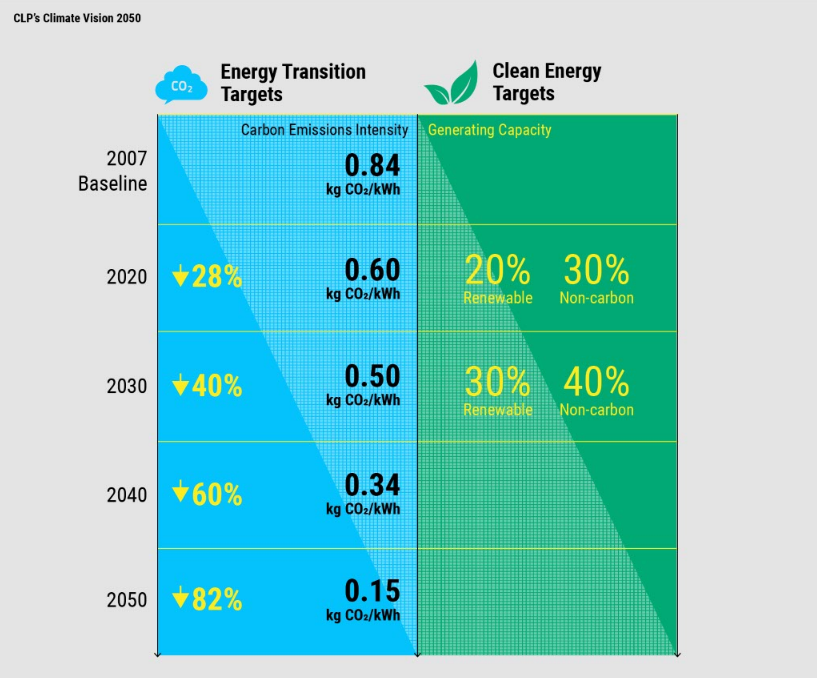CLP's Transition Towards a Low Carbon Future

As featured in the CLP Group's 2017 Sustainability Report
The CLP Group has developed strategies to address renewable resources and global climate change since 2004. To meet the challenges ahead, the power company has updated its Climate Vision 2050, building on the optimism of CLP's original aspirational, science-based trajectory while taking into consideration the realities of the energy market development in the Asia-Pacific region.
Updated Climate Vision 2050
CLP's changes to the targets include:
- Tightening of its cornerstone carbon intensity reduction target from 75% to 82% by 2050 compared with 2007;
- Developing new interim carbon intensity reduction targets of 40% by 2030 and 60% by 2040 compared with 2007. CLP has removed the previous interim target for 2035 to better align with the Paris Agreement timeline as well as the United Nations Sustainable Development Goals, which focus mostly on 2030; and
- Establishing a renewable energy target of 30% and a non-carbon emitting target of 40% by 2030, considering the growing significance of solar and wind in new capacity additions globally.
CLP believes these new targets are challenging and ambitious and it will review them regularly to ensure that it takes into account the momentum of change over time. For a more holistic picture of power capacity requirements, it will also begin to report its progress on these targets on a basis that includes capacity purchases in addition to the facilities that it owns and operates. The two new targets on renewable energy and non-carbon emitting energy for 2030 will also take into account the capacity purchases it makes.
CLP's climate journey
CLP's climate change journey began back in 2004, when it published its first renewable energy target of 5% by 2010. In 2007, the company set a carbon intensity reduction target of around 75% by 2050 compared to 2007 levels, which was based on the scenarios presented in the Energy Technology Perspectives 2006 publication from the International Energy Agency. This target became the cornerstone of the Group's Climate Vision 2050, and was supported by a series of interim carbon emissions intensity targets in 2010, 2020, and 2035. CLP is amongst the first power utilities in the world to commit to a carbon reduction pathway.
In 2010, the Climate Vision 2050 was updated and the 2020 carbon intensity target was stepped up from 0.7kg CO2 / kWh – a reduction of around 15% from 2007 levels – to 0.6kg CO2/kWh, a reduction of around 30%. Having already met the 5% target, we set a new 2020 renewable energy target of 20% and a non-carbon emitting target for the same year of 30%, including nuclear power.
CLP had previously committed to reviewing its Climate Vision 2050 roadmap in 2018, after the Intergovernmental Panel on Climate Change releases its new 1.5°C emissions scenario projections. Given the positive momentum created by the successful ratification of the Paris Agreement on climate change, as well as one of the Financial Stability Board’s Recommendations of the Task Force on Climate-related Financial Disclosures being the use of 2°C scenario analyses, CLP believed it was appropriate to start this review a year earlier in 2017.
Reviewing Climate Vision 2050
A great deal has changed in the climate change arena since CLP published its Climate Vision 2050 in 2007. Most world leaders have signed up to the Paris Agreement and there have been giant strides in climate change science, technology and social expectations.
In reviewing the Climate Vision 2050, CLP carried out scenario analyses to test the impact on its business of varying speeds of transition to a low carbon future in each of its markets, along with different options for implementing its approach. CLP developed realistic simulations of how the business would look under slow, medium, and fast transition scenarios and set them against the International Energy Agency’s World Energy Outlook 2016 projections for world and regional energy development. It transpired that the targets CLP set a decade ago had predicted the future relatively well and were close to the medium-speed scenario that assumes countries will meet the targets set out in the Paris Agreement.
Although CLP's original targets were still valid considering the anticipated pace of change in the region, the company believed there was room for improvement. Now, to further support the Paris Agreement goals, CLP has set even more ambitious targets.
To learn more, read the CLP Group's 2017 Sustainability Report.
Information on how CLP is moving towards clean energy is available here.

